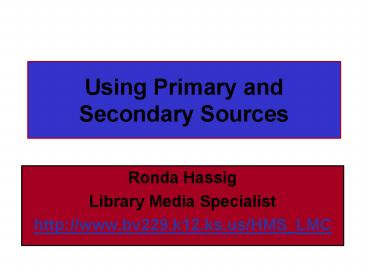Using Primary and Secondary Sources - PowerPoint PPT Presentation
1 / 28
Title:
Using Primary and Secondary Sources
Description:
Remember the first dictionary wasn't published until 1775! How can the historical ... Videotape of 'I have a dream' speech. Primary or Secondary Source? ... – PowerPoint PPT presentation
Number of Views:189
Avg rating:3.0/5.0
Title: Using Primary and Secondary Sources
1
Using Primary and Secondary Sources
- Ronda Hassig
- Library Media Specialist
- http//www.bv229.k12.ks.us/HMS_LMC
2
What is our goal today?
- What is the Historical Record?
- What is a primary and secondary source?
- Location and access of sources
- Evaluation of sources
- Harmony Web Site
3
What is a secondary source? Author is not an
eyewitness or participant in the historical event
they are writing about.
- Reference books encyclopedias, historical
dictionaries atlases - Periodicals National Geographic, Historical
America, Civil War Times - Textbooks History
- General Historical works
- Monographs non-fiction books on a particular
subject - Journal Articles Journal of American History,
Journal of Womens History - Almanac
- Newspapers
- CD Rom
- Laser Disk
- Internet
4
Secondary Source Example
5
(No Transcript)
6
You want to always start your research with
secondary sources. They help to put your topic in
an historical perspective, or in the larger
historical context. Secondary sources will also
lead you to Primary sources. Check for
pictures, quotes, bibliography
7
What is a primary source? Material that is
written or produced in that time period -
authentic
- Letters and diaries
- Songs/hymns
- Photographs
- Tools, machines, furniture other artifacts from
another era - Court proceedings
- Government records
- Newspapers published during the period you are
researching - Treaties Trade agreements
- Census data
- Oral History interviews
- Autobiographies
- Speeches/Quotes
- Museum Displays
8
Primary Source Example
9
National Archives Records Administration.
(2000) Chiricahau Apache prisoners. Photograph.
Westward Expansion Almanac. Detroit UXL, p145.
10
Diary entry from Lewis and Clark
Expedition Hunsaker, J. (2001). Sacagawea Speaks.
Guilford Globe Pequot Prexx, p17.
11
Location and Access of Sources
- School Libraries
- University Libraries
- Historical Societies
- Public Libraries
- Museums
- Internet
- Your attic or basement!
12
Internet Web Sites for Primary Sources
- http//lcweb.loc.gov
- http//members.aol.com/calebj/mayflower.html
- http//www.earlyamerica.com/earlyamerica
- http//www.pbs.org/ktca/liberty
- http//www.history.org
- http//www.pbs.org/lewisandclark/archive
- http//www.wiesenthal.com/library/service.cfm
- http//www.ushmm.org
- http//remember.org/
- http//www.nara.gov
- http//www.fbi.gov
- http//www.yale.edu/lawweb/avalon/avalon.htm
- http//etext.lib.virginia.edu/eng-on.html
13
Evaluation of Sources
- All historians evaluate sources using two
rules - Time and place
- Bias rule
14
Time and Place
- The closer in time and place a source and its
creator were to the event the better the source.
Here are four sources, with most reliable first - Artifacts
- Accounts of the event, created at the time it
happened, by first hand observers or
participants. - Accounts of the event, created after it happened,
by first hand observers or participants. - Accounts of the event, created after it happened,
by people who didnt participate or witness the
event, but used interviews or evidence from the
time of the event.
15
Bias Rule
Every source has a bias! Documents tell us what
the creator of the document thought happened, or
what they want us to think happened. So follow
these rules What was the authors reason for
writing it, taking it, or interviewing for it.
16
Validity and reliability Always triangulate
your sources. Never count on 1 source! Example
Stonehenge
17
Things to remember
- Cite ALL sources in your bibliography.
- Typically, primary sources have no
- bibliography, secondary sources have a
bibliography. - Watch for BIAS its not bad as long as you know
its there! - Note that some primary sources can be
controversial - particularly slaves accounts and race relations
BE AWARE! - Some primary sources are hard to read script is
archaic and words look misspelled. - Remember the first dictionary wasnt published
until 1775!
18
How can the historical record be so large and
yet so limited?
http//www.bv229.k12.ks.us/hms_lmc
19
Lets see if we can distinguish a primary source
from a secondary source!
20
Primary or Secondary?
Videotape of I have a dream speech
21
Primary or Secondary Source?
22
Primary or Secondary?
23
Primary or Secondary Source?
24
Primary or Secondary?
25
Primary or Secondary?
26
Primary or Secondary?
27
Primary or Secondary Source?
28
Primary or Secondary?































